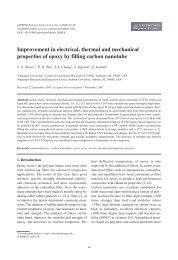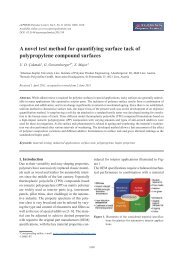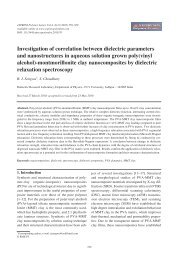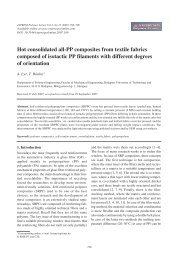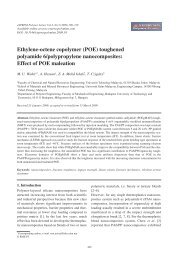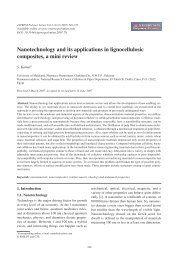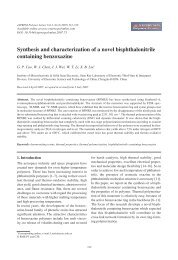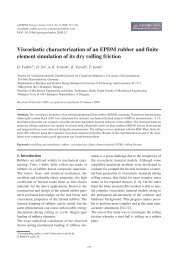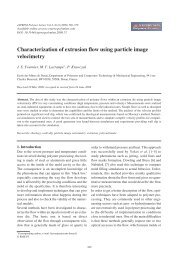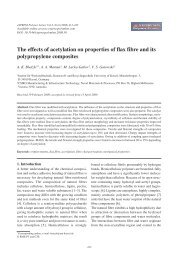Starch-based completely biodegradable polymer materials
Starch-based completely biodegradable polymer materials
Starch-based completely biodegradable polymer materials
Create successful ePaper yourself
Turn your PDF publications into a flip-book with our unique Google optimized e-Paper software.
Lu et al. – eXPRESS Polymer Letters Vol.3, No.6 (2009) 366–375<br />
Table 2. Thermal and mechanical properties of thermoplastic starch/polycaprolactone (TPS/PCL) blends<br />
Content of TPS<br />
T g [°C]<br />
Tensile Strength<br />
Elongation at Break<br />
[wt%]<br />
PCL<br />
TPS<br />
[MPa]<br />
[%]<br />
100 (TPS1) a – 08.4 3.3 126.0<br />
075 (TPS1) 31.0 5.9 62.6<br />
100 (TPS2) a – 43.4 21.4 3.8<br />
075 (TPS2) 41 10.5 2.0<br />
060 (TPS2) NF b 9.0 2.4<br />
0 –61.5 – 14.2 >550.0<br />
a the content of glycerol and water in TPS1 and TPS2 are 18 and 12, 10 and 16 wt% respectively<br />
b T g value is not found in the literature<br />
impact resistance and the dimensional stability of<br />
native starch is improved significantly. The glass<br />
transition temperature and mechanical properties of<br />
TPS/PCL blend are varied with its composition and<br />
the content of plasticizer (Table 2) [32]. As can be<br />
seen, TPS/PCL blend is similar to TPS/PLA blend<br />
in both the compatibility and the role of components.<br />
PCL/starch blends can be further reinforced with<br />
fiber and nano-clay respectively. Moreover, the<br />
other properties of the blends such as hydrolytic<br />
stability, degradation rate, and compatibilization<br />
between PCL and starch are also improved [34, 35].<br />
PVA is a synthetic water-soluble and <strong>biodegradable</strong><br />
<strong>polymer</strong> [36]. PVA has excellent mechanical<br />
properties and compatibility with starch. PVA/<br />
starch blend is assumed to be <strong>biodegradable</strong> since<br />
both components are <strong>biodegradable</strong> in various<br />
microbial environments. The biodegradability of<br />
blends consisting of starch, PVA, glycerol and urea<br />
is performed by bacteria and fungi isolated from the<br />
activated sludge of a municipal sewage plant and<br />
landfill, which indicate that microorganisms consumed<br />
starch and the amorphous region of PVA as<br />
well as the plasticizers [37]. Meanwhile, the blend<br />
is expected to exhibit good mechanical and process<br />
properties [38, 39]. Owing to the strong interaction<br />
among hydroxyl groups on PVA and starch chains,<br />
all the T g of the starch/PVA blends of different<br />
compositions are lower than that of PVA. The<br />
excellent compatibility of two components make<br />
the tensile strength of the blend increases with<br />
increasing PVA concentration, and the elongation<br />
at break of the blend is almost kept constant [37].<br />
In addition, PVA can be used to enhance the compatibility<br />
of starch/PLA blends. Because both<br />
starch and PVA are polyols, starch will form continuous<br />
phase with PVA during blending. As a<br />
result, the mechanical properties of the starch/PLA<br />
blends are improved in the presence of PVA [40].<br />
As for the blend system without PVA, starch acts as<br />
filler in the PLA continuous matrix. PLA acts as the<br />
main load-bearing phase because of the weak interaction<br />
between starch and PLA.<br />
3.1.2. Blend with bio<strong>polymer</strong>s<br />
Natural <strong>polymer</strong>s such as chitosan and cellulose<br />
and their derivatives are inherently <strong>biodegradable</strong>,<br />
and exhibit unique properties. A number of investigations<br />
have been devoted to study the blend of<br />
them with starch.<br />
<strong>Starch</strong> and chitosan are abundant naturally occurring<br />
polysaccharide. Both of them are cheap,<br />
renewable, non-toxic, and <strong>biodegradable</strong> [41]. The<br />
starch/chitosan blend exhibits good film forming<br />
property, which is attributed to the inter- and intramolecular<br />
hydrogen bonding that formed between<br />
amino groups and hydroxyl groups on the backbone<br />
of two components. The mechanical properties,<br />
water barrier properties, and miscibility of<br />
<strong>biodegradable</strong> blend films are affected by the ratio<br />
of starch and chitosan [42].<br />
Extrusion of the mixture of corn starch and microcrystalline<br />
cellulose in the presence or absence of<br />
plasticizers (polyols) is used to produce edible<br />
films [43]. By increasing the content of the cellulose<br />
component, the rupture strength is increased,<br />
whereas the elongation at break and the permeability<br />
of films for water vapor are decreased. <strong>Starch</strong><br />
can form thermodynamically compatible blend<br />
films with water-soluble carboxymethylcellulose<br />
(CMC) when the starch content is below 25 mass%<br />
[44]. Such films are <strong>biodegradable</strong> in presence of<br />
microorganisms.<br />
<strong>Starch</strong>-<strong>based</strong> nanocomposite film is obtained by<br />
casting the mixture of plasticized starch and flax<br />
cellulose nanocrystals. The mechanical properties<br />
369




